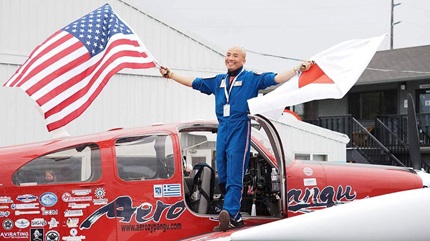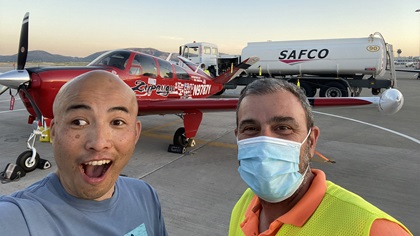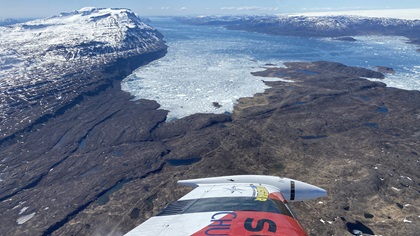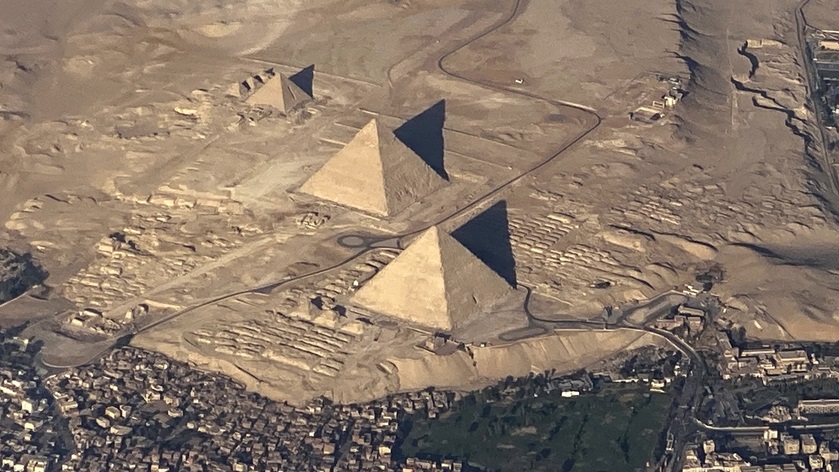Maeda completes circumnavigation in Bonanza
One-eyed pilot spreads message of perseverance
“Mission accomplished!” exclaimed one-eyed pilot Shinji Maeda on June 11 after completing a circumnavigation of the Earth in a 1963 Beechcraft Bonanza V-tail during a mission of perseverance that he said seemed more like Mission Impossible after beginning May 1 at Paine Field in Washington.
When Maeda emerged victoriously from Lucy, the red P-model Bonanza, he waved U.S. and Japanese flags before tearfully embracing his wife, Makiko, and children Tsubasa and Sana. “I am home,” he declared after encountering the highs and lows of a mission that mentor and fellow circumnavigator Adrian Eichhorn previously warned him about. Weather—including sandblasting from a Sahara Desert storm, fog in Russia, and brief but harrowing icing conditions—was a factor along the route.
The idea for his lifelong “mission possible” mantra began with encouragement from Maeda’s father to emigrate to the United States and pursue an aviation science degree at Embry-Riddle Aeronautical University in Arizona. A college flight instructor reignited Maeda’s passion for flight and the federal air surgeon granted Maeda a statement of demonstrated ability. He earned a private pilot certificate, an instrument rating, and a commercial pilot certificate, and became a certificated flight instructor.

Through virtual or in-person appearances, social media postings, and videos, Maeda has been encouraging young people to explore aviation as a valuable skill. He recognized that flying is a good skill for those considering science, technology, engineering, or math careers and has been vocal about it since he founded the nonprofit Aero Zypangu Project (Air Japan) in 2015. The around-the-world flight was a culmination of the messages of hope that Maeda dispenses to others.
Some of the biggest circumnavigation roadblocks—besides loneliness—were bureaucratic. “That’s why this mission flight absolutely pushed my absolute limit over whatever I’ve done in the past,” he said. Last-minute complications including the FAA refusal of his request for an in-cockpit ferry tank, re-routings, fuel availability concerns, weather systems, and continued coronavirus pandemic protocols were the order of the day during the 18-country, six-week mission.
The coronavirus pandemic that originally forced a one-year delay from 2020 continued to play a key role when Maeda was unable to hug his ailing mother during a planned stop in his home country of Japan. Instead of hugs and kisses, he could only communicate with her through a chain-link airport security fence because of strict COVID-19 regulations. Despite the disappointment, a group of family members and friends gathered to support the aerospace engineer shouting encouragement and holding homemade signs before he departed for Korea, Russia, and then a return to the United States via Alaska.

Maeda complimented his support team including Eichhorn; General Aviation Support Egypt; and a group of friends and colleagues at Boeing Co., who kept tabs on him and helped with weather, logistics, and radio relays.
Maeda said he learned a lot during the trip, but “flying the airplane” remained at the top of his list. He said pilots are taught “three rules to aviate, navigate, and communicate. In my case during almost all the flights it was pretty much [to] aviate. Fly, fly, fly, even if you think you’re lost, just fly the airplane.” Maeda found that traffic controllers use different styles outside of the United States, so he “had to rely on myself, so my focus was absolutely to aviate. This lesson will never change for the rest of my life.”
Maeda said he was encouraged by the people he met along the route and he credited their positivity for helping keep him on track. “They were just amazing, they were beautiful,” he recalled, and “they gave us big smiles” when he and Lucy landed. Line personnel posed for pictures, helped him secure places to rest, and assisted with other duties. “They congratulated me visiting their countries even with Covid circumstances” as he shared the worldwide flight of perseverance, passion, and possibility through social media postings and videos. “Everybody was happy. That was the most beautiful thing.”
Flying over Greenland with Eichhorn at his side in another Beechcraft Bonanza during his mentor’s May polar crossing was another “breathtaking moment” etched into Maeda’s soul. “It was crystal clear. It was just an amazing view with perfect VFR conditions and no clouds.” Then the reality of flying over the vast expanse of uninhabited terrain hit. “Looking down upon the glaciers and snow I was telling my airplane, ‘Lucy, don’t stop your engine. Don’t stop, keep going, honey.’”

Flying into his homeland of Japan was both a highlight and a lowlight. He originally planned a more extravagant arrival to showcase his ability to earn a pilot certificate despite his home country labeling him “disabled” and to serve as a role model for others but was thwarted. “Officially, I made Japanese aviation history today,” he wrote on Facebook after landing in Okinawa. “Who said [a] handicapped person cannot get [a pilot] license, [and] cannot fly?” Despite not being able to socialize with his mother, Maeda reflected on the plight of others around the world who lost loved ones during the global crisis. “What I can say is, I am really lucky because I was able to see my mom and I was able to see her smiles. That’s good and that’s all I need for now.”
Before Maeda’s father died three years ago, he pushed his son to share the personal story of perseverance with others. The idea launched Aero Zypangu, which combines Maeda’s life experiences with a never-give-up attitude that encourages others to follow their own dreams. Upon landing in Japan, he paid respect to the man who was an inspiration and a bedrock of support. “Dad, thank you. I flew in Hokkaido, today, but sorry I was not able to fly over our home. Maybe next time.”
Maeda said when people apply the right mindset and the right attitude toward their lives, “things will happen” in their favor. “Spend the time, make the relationships with the right people, and guess what? You can go from an attitude of ‘that’s impossible’ to one of ‘I am possible.’ Celebrating aviation, celebrating our lives, and spreading a message of hope to others is all we need.”





